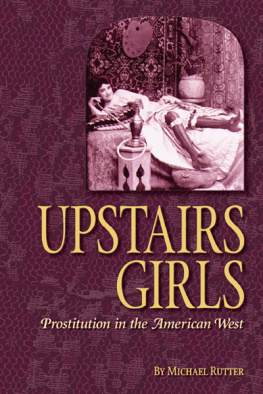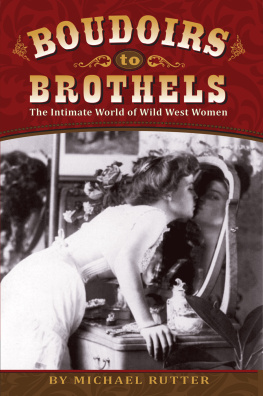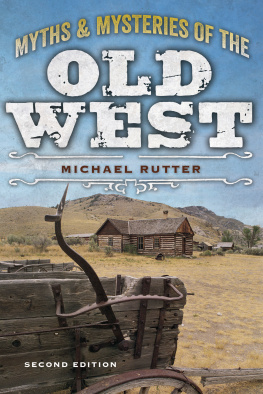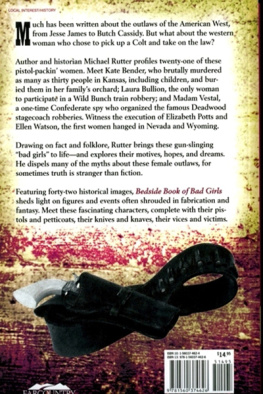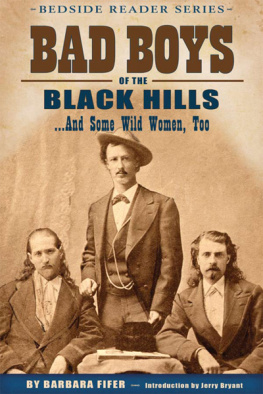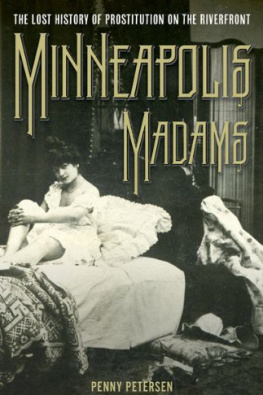

upstairs girl: a prostitute. Most establishments were located on the second story of a building for privacy, security, and protection.
ebook ISBN: 978-1-56037-542-5
print ISBN: 978-1-56037-357-5
2005 Farcountry Press
Text 2005 Michael Rutter
1, 2012
Cover photo: Woman lying down with Nargileh. 1902 PHOTOGRAPH BY CHARLES ELLIS JOHNSON. SPECIAL COLLECTIONS AND ARCHIVES, MERRILL LIBRARY, UTAH STATE UNIVERSITY.
This book may not be reproduced in whole or in part by any means (with the exception of short quotes for the purpose of review) without the permission of the publisher.
For more information on our books, write Farcountry Press, P.O. Box 5630, Helena, MT 59604; call (800) 821-3874; or visit www.farcountrypress.com.
Foreword
Fiction, History, and Reading the West
U pstairs Girls is a serious, engaging examination of the significant role that ladies for hire played in the settling of the Westwith particular emphasis on issues of gender, class, and race. It represents a window opened on to the lives of these soiled doves and dancehall girls.
As Rutter has pointed out consistently in his writings on Western history, for most of us, the West exists largely as a mythic placetinged with only a bit of reality. It is haunted by legendary characters and events that continue to fuel our imaginations and influence the way we view the West today.
Portrayals in the mediafrom films, television programs, and novels to music and advertisingall contribute to the imaginative, legendary construction of the West. Our historical touchstones, it seems, tend to be figures of fiction. How, for example, do we separate the actual historical figure of George Armstrong Custer from his portrayal in Evan S. Connells Son of the Morning Star or in Thomas Bergers Little Big Man or in their film adaptations? Or the actual Martha Jane Canary Burke, alias Calamity Jane, from the performances by Doris Day in Calamity Jane or by Anjelica Huston in Buffalo Girls?
Prostitutes and dancehall girls of the Old West are stock figures in film and literature. They range from the happy, heart of gold tarts of The Cheyenne Social Club to the vengeful, bounty-offering whores of Unforgiven . Sometimes, however, they take on a more dynamic dimension with particular identities: Lorena from Larry McMurtrys Lonesome Dove and Streets of Laredo or Hattie from Jack Warner Schaefers Monte Walsh. Indeed, portrayals of women who worked as prostitutes run the gamut from well-rounded to stereotypical.
And so it is with the ladies for hire discussed in this book. Most belong to the great anonymous group of working girls, although somesuch as Julia Bulette, Fanny Porter, Rosa May, and Ah Toyhave become Western legends. Some kept company with outlaws and other famous figures, which only added to their legends. Annie Porter, for example, had a long-term affair with Harvey Logan, a.k.a. Kid Curry, of the Wild Bunch. Mary Katherine Haroney, or Big Nose Kate, had an often exciting, up-and-down relationship with John Doc Holliday over several years. Given the male-centered nature of the Old West, it shouldnt be surprising that the legendary status of these fallen women depended largely on their relationships with men, both professionally and personally.
As Rutter points out in his introduction, the social position of women in the Old West operated according to a strict binary code: There were decent women and sporting women. The treatment women received varied greatly depending how they were classifiedthe former receiving social respect and the latter, social rejection. These two groups never mixed, of course, perhaps to protect decent women from the taint of the fallen and perhaps to protect their husbands, who may have been tainted already. The hypocrisy inherent in this division demonstrates the sexism that pervades the industry of Old West prostitution and that is at the heart of the books historical critique.
Michael argues persuasively that the vast majority of women entered prostitution for economic reasons. Unless she was married, a woman could barely make ends meet working other kinds of jobs, none of which paid well and all of which were very labor intensive. In short, prostitution paidespecially if a woman worked in one of the high-class bordellos and not one of the dirty cribs or back alleyways. However, as the book makes clear, prostitution was rarely an upwardly mobile enterprise as most of the women ended up poor, diseased, and addicted to drugs. The economic benefits of Old West prostitution, which was a million-dollar business, came mostly to the madams, pimps, and landlords. No wonder the rate of suicide among ladies for hire was so high.
Upstairs Girls chronicles an important but largely unknown chapter in the history of the West and ties it to other significant stories with which were quite familiar, such as mining, cattle raising, railroad building, boom-town gambling, and outlaw trailing. Its a welcome addition to popular Western history, as well as legendary Western fiction. Rutter works hard to separate the twowhile acknowledging that history and fiction are sometimes far too intertwined to do so.
Upstairs Girls is an engaging readone that honors the lives and struggles of some of the most fascinating figures in the American West.
Phillip A. Snyder, PhD
American Studies Coordinator
Brigham Young University
Introduction
W omen were scarce on the early Western landscape. Legend has it that one homesick mountain man walked thirty miles to see a young mother and reportedly offered her $50 if he could hold her baby. And it was rumored that a lonesome forty-niner paid $10 in gold for the first biscuit out of Luzena Wilsons oven.
Adding to this novelty was a harsh dichotomy. There was a firm line drawn between the so-called decent woman, who was respected and venerated, and a prostitute, a woman of easy virtue. Except in boom-towns or rough settlements, a fallen woman forfeited most of her rights and all of her respect when she entered this line of work.
A decent woman, even in the rough-and-tumble towns, could expect a certain degree of protection and safety. Abuse in any of its ugly forms was a hanging offense. However, if a prostitute was beaten up, raped, or abused, more often than not the general consensus was that she got what she deserved since she was a whore. There was no lynching party protecting her honor.
A decent woman could have nothing to do with her fallen sister. The code of the day demanded that a good woman completely ignore the lady of the evening at all timesas if the latters sin, like leprosy, could rub off and infect. Conversely, a prostitute initiating some sort of association with a decent woman or children on the street would be the fastest way for that soiled dove to be physically thrown out of town. Such a breach of frontier etiquette was not tolerated. By association, dancehall girlswho rarely had any involvement in the sex tradewere treated in the same fashion. They were simply one rung above the prostitute on the Western social scale.
There were certain genteel expectations for womanhoodthe most important was to act like a lady (even though no one seemed to be certain what that meant exactly). Another was to get married and raise a family. While women and womanhood were revered, there wasnt much vocational latitude. If for some reason the wedding bells didnt ring, or didnt ring true, or a husband died, options were limited. She might eke out a living as a cook, a teacher, or a laundress. If she happened to be handy with needle and thread, she might try her hand as a seamstress. If she could make three shirts a day (which was about average in a twelve-hour day), she might earn between 50 cents to $2 a week (depending on where she lived)barely enough to keep her or her family alive. If one wasnt a family woman or a woman of means, the frontier wasnt always a land of promise. Sometimes there appeared to be but one avenue.
Next page
